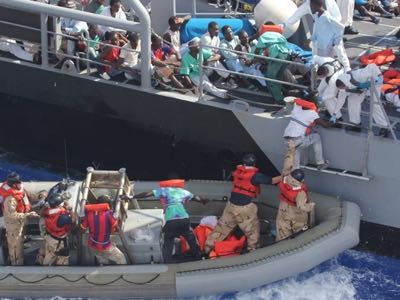
“Identify, capture and systematically destroy the boats used for human trafficking, dismantle their networks and seize their goods”: this is the task of the CFSP mission (the European Policy on Security and Defense) that the EU High Representative Federica Mogherini is mandated to carry out. While it is very clear what needs to be done, there is no clarity on how it will be done. Comparison with other missions, such as Atalanta formally targetted against piracy in the Horn of Africa, which involved the Italian military marine, is inconsistent: in the Indian Ocean the issue is preventing agile ships with few armed persons on board, boarding commercial ships; [but] in the Mediterranean the issue is isolating and destroying the ships in the Libyan ports before they are used by traffickers or to capture them if they are already at sea.
– Issue No. 1: how do you distinguish the traffickers’ ships from commercial ships for transport and fishing when they are in port?
– Issue No. 2: let us say that, using a drone or satellite you are able to identify a trafficker’s ship whilst it is in port, how can you destroy it? With a drone, armed with missiles (the type the USA used, which killed an Italian collaborator in Pakistan) or a fighter bomber such as Eurofighter Typhoon, which will trigger a massacre of civilians? Or with special forces that disembark during the night from a submarine, that will have to face an armed skirmish with several milizia? And if the ship takes to the sea, jam-packed with refugees, how do you use a warship to block it without causing a massacre?
– Issue No. 3: how do you dismantle the network of traffickers without sending military forces onto Libyan territory. Because none of this is at all clear, the CFSP’s mission, which sounds very good with its lofty intentions, will be transformed into a “Brancaleone Armada” set up for failure.
Or it is precisely for this reason that it was launched? If the CFSP mission fails, Nato is ready “to run to help” the EU. Last February at Rome, the Nato Secretary General, Jens Stoltenberg, warned that “the deteriorating situation in Libya could induce new threats to European security” and that “Nato must be ready to defend every ally from such threats”. Thus it announced that, from 2016, a new system will be in operation at Sigonella: AGS (Alliance Ground Surveillance) that, with Global Hawks drones and other instruments, will enable the surveillance of a vast area from Africa to the Middle East, to support Nato operations, in particular “Response Force” operations. The first testing ground will be Libya where, Stoltenberg said, “the situation is out of control’ (forgetting how Nato used force to demolish the Libyan state), but “Nato is ready to support the Libyan authorities”.
Mission CFSP therefore constitutes the picklock of another operation under Nato leadership, which is prepared by making use of the hecatombs of refugees in the Mediterranean to shift public opinion in favour of direct military intervention in Libya. It takes the form of a landing, shown all over the world, of collaborators and Red Cross nurses for an “extraordinary humanitarian initiative” that, given the chaos that reigns in the country, will have to take place under military “protection”. With the genuine intention of establishing a bridge head test in Libya, by occupying the most important coastal zones, not only in terms of energy resources but also on account of their geographical position at the intersection between the Mediterranean, Africa and the Middle East.

 Articles by this author
Articles by this author Send a message
Send a message




























Stay In Touch
Follow us on social networks
Subscribe to weekly newsletter